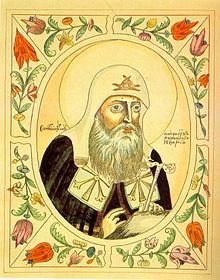Hermogenes of Moscow
| Patriarch Hermogenes | |
|---|---|
| Patriarch of Moscow and all the Rus' | |
 |
|
| Church | Russian Orthodox Church |
| See | Moscow |
| Installed | 1606 |
| Predecessor | Patriarch Ignatius |
| Successor | Patriarch Filaret |
| Personal details | |
| Born | Russia |
| Buried | Dormition Cathedral, Moscow |
| Profession | Civil Servant, Tsardom of Russia |
Hermogenes, or Germogen (Russian: Гермоге́н) (secular name Yermolay) (before 1530 – February 17, 1612) was the Patriarch of Moscow and all Russia from 1606. It was he who inspired the popular uprising that put an end to the Time of Troubles. Hermogenes was glorified by the Russian Orthodox Church in 1913.
At the Holy Synod of 1589, which established the patriarchy in Moscow, Hermogenes was appointed Metropolitan of the newly conquered city of Kazan. During the following two decades, he gained renown for a number of Muslim Volga Tatars converted to Eastern Orthodoxy.
In 1606, Hermogenes was summoned by False Dmitry I to take part in the Senate recently instituted in Moscow. There he learnt about the tsar's design to marry a Roman Catholic woman, Marina Mniszech, and firmly declared against such an alliance. At that he was exiled from the capital, only to return with great honours several months later, when the false tsar had been deposed, and Patriarch Ignatius followed suit.
The new tsar, Vasily IV, helped Hermogenes to become Patriarch of Moscow and all the Rus': Metropolitan Hermogenes was elected to the primatial See, and on July 3, 1606 he was installed as Patriarch by the assembly of the holy hierarchs at Moscow's Dormition cathedral. Metropolitan Isidore handed the Patriarch the staff of the holy hierarch Peter, and the Tsar gave as a gift to the new Patriarch a panagia, embellished with precious stones, a white klobuk and staff. In the ancient manner, Patriarch Hermogenes made his entrance riding upon a donkey. During Vasily's reign, Hermogenes generally supported the tsar's efforts to pacify the country and anathemized Ivan Bolotnikov and his army.
...
Wikipedia
